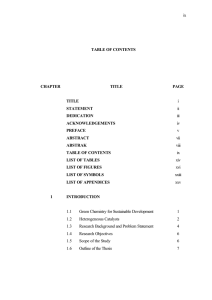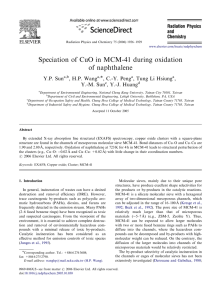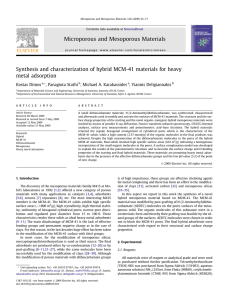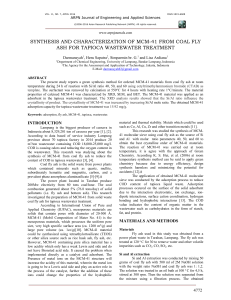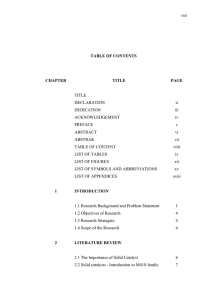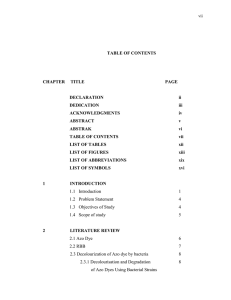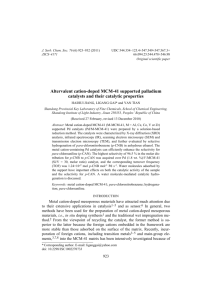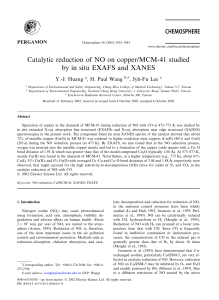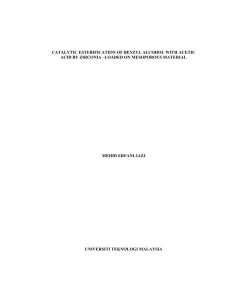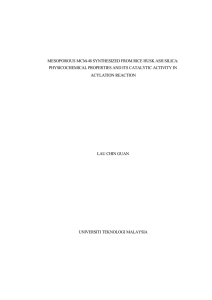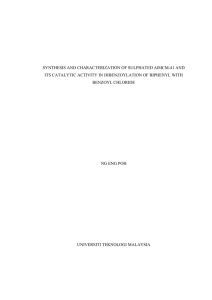Senior Sem Mesoporous Assignment
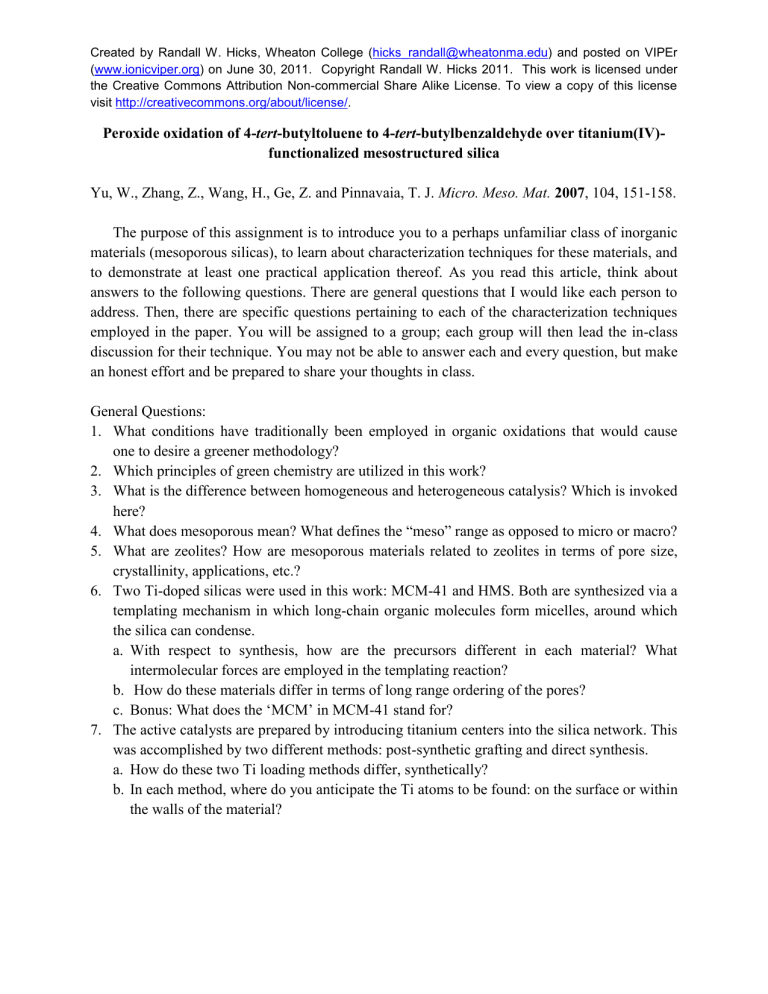
Created by Randall W. Hicks, Wheaton College ( hicks_randall@wheatonma.edu
) and posted on VIPEr
( www.ionicviper.org
) on June 30, 2011. Copyright Randall W. Hicks 2011. This work is licensed under the Creative Commons Attribution Non-commercial Share Alike License. To view a copy of this license visit http://creativecommons.org/about/license/ .
Peroxide oxidation of 4-tert-butyltoluene to 4-tert-butylbenzaldehyde over titanium(IV)functionalized mesostructured silica
Yu, W., Zhang, Z., Wang, H., Ge, Z. and Pinnavaia, T. J. Micro. Meso. Mat.
2007 , 104, 151-158.
The purpose of this assignment is to introduce you to a perhaps unfamiliar class of inorganic materials (mesoporous silicas), to learn about characterization techniques for these materials, and to demonstrate at least one practical application thereof. As you read this article, think about answers to the following questions. There are general questions that I would like each person to address. Then, there are specific questions pertaining to each of the characterization techniques employed in the paper. You will be assigned to a group; each group will then lead the in-class discussion for their technique. You may not be able to answer each and every question, but make an honest effort and be prepared to share your thoughts in class.
General Questions:
1. What conditions have traditionally been employed in organic oxidations that would cause one to desire a greener methodology?
2. Which principles of green chemistry are utilized in this work?
3. What is the difference between homogeneous and heterogeneous catalysis? Which is invoked here?
4. What does mesoporous mean? What defines the “meso” range as opposed to micro or macro?
5. What are zeolites? How are mesoporous materials related to zeolites in terms of pore size, crystallinity, applications, etc.?
6. Two Ti-doped silicas were used in this work: MCM-41 and HMS. Both are synthesized via a templating mechanism in which long-chain organic molecules form micelles, around which the silica can condense. a. With respect to synthesis, how are the precursors different in each material? What intermolecular forces are employed in the templating reaction? b. How do these materials differ in terms of long range ordering of the pores? c. Bonus: What does the ‘MCM’ in MCM-41 stand for?
7. The active catalysts are prepared by introducing titanium centers into the silica network. This was accomplished by two different methods: post-synthetic grafting and direct synthesis. a. How do these two Ti loading methods differ, synthetically? b. In each method, where do you anticipate the Ti atoms to be found: on the surface or within the walls of the material?
Characterization Methods
Your group will be assigned one method (or group of methods) to research and report on. For each method, be able to state what specific information was obtained in this study that enabled the authors to support their conclusions. Particularly, interpret the figures.
A: X-ray Diffraction (XRD)
1. What is Bragg’s Law of diffraction?
2. What is plotted in an XRD pattern? What do the peaks (reflections) correspond to?
3. If the spacing, d, is 4.0 Å, at what value of 2Θ would a peak appear? (See the experimental section for an appropriate wavelength.)
4. In section 3.1., the authors state that low angle (2Θ < 10°) reflections are exhibited for
MCM-41 and HMS materials. What structural feature of these materials gives rise to these low angle reflections? Why are there more peaks in the MCM-41 pattern than in the HMS pattern? See the copy of Figure 1 (A and C) from Chem. Mater. 1996, 8, 8, 2071 for representative XRD patterns of these materials.
5. What evidence do the authors cite to support the conclusion that the mesostructure is retained upon loading the Ti? If bulk TiO
2
is formed, what would be seen in the XRD patterns?
B: Nitrogen Adsorption
In this technique, a sample of a porous material is placed in a glass tube and evacuated under heat to drive off any adsorbed moisture or vapor. The dried, evacuated sample is then chilled to liquid nitrogen temperature (by, not surprisingly, placing the tube in a dewar of liquid nitrogen).
Gaseous nitrogen is then slowly introduced into the tube where it adsorbs onto the surface of the solid. Layers of gas molecules build up until eventually the pores are filled. See Figure 1 for the so-called nitrogen adsorption isotherms.
1. What is plotted in the adsorption isotherm? How can information such as surface area, pore size (diameter) and pore volume be extracted from the plot?
2. What gives rise to the uptake of gas at values of P/P o
< 0.10? From P/P o
of 0.20 – 0.50?
Above P/P o
of 0.90?
3. Which material takes up nitrogen more steeply around P/P o
≈ 0.40? What does this imply about the distribution of pore size (diameter) in the materials?
4. What evidence exists that the mesostructure is retained upon loading of Ti?
5. What trend in both pore volume and surface area is expected as the loading of Ti by postsynthetic grafting increases? Is this borne out by the data in Table 1?
C: Diffuse Reflectance UV-Vis Spectroscopy
1. Ignoring the Kubelka-Munk function, what is generally plotted in the UV-Vis absorbance spectrum?
2. To what is the peak centered near 230 nm attributed?
3. Is there evidence that TiO
2
has segregated from the material?
D: Infrared Spectroscopy
1. The authors state that a peak in the IR spectrum near 980 cm
-1
is due to “site isolated” Ti centers. Sketch a site isolated Ti center. How does this compare to a Ti atom that is not site isolated?
2. What is TS-1? How does it compare to the MCM-41 and HMS materials?
E: Nuclear Magnetic Resonance
1. What is magic angle spinning (MAS) and why is employed when obtaining NMR spectra of solids?
2. What is the natural abundance of the NMR active 29 Si isotope?
3. The authors refer to Q
2
, Q
3
, and Q
4
sites within the materials. What does this mean? Sketch what each of these would look like.
4. In the paper, what does f
SiOH
represent?
5. Why does f
SiOH
decrease with increased Ti loading by post-synthetic grafting?
Catalysis
1. What is meant by ‘conversion?’ Under which conditions were the best conversions achieved?
2. Comment on the selectivity of the reaction. What are the major and minor products?
3. What is the general trend in conversion as a function of loading of Ti?
4. What reasons were cited for the relatively poor performance of hydrogen peroxide as an oxidizing agent?
5. How do the conversions achieved over the 2.8% Ti-HMS(1) and 2.8% Ti-MCM-41 samples compare to that achieved using 2% Ti-HMS(DS). Suggest a reason to explain these differences.
6. Define turnover number (TON). This is given in the last two columns of Table 3. What is the trend in TON as the loading of Ti increases?
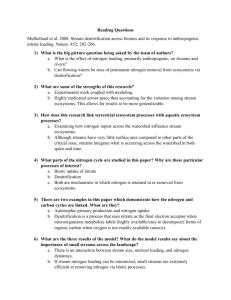





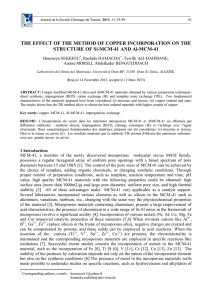
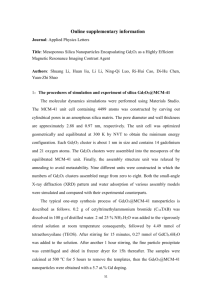
![Coordination state of Cu+ ions in Cu-[Al]MCM-41](http://s2.studylib.net/store/data/018680249_1-9277e46c5f24c2bfb628b40764a9612b-300x300.png)
